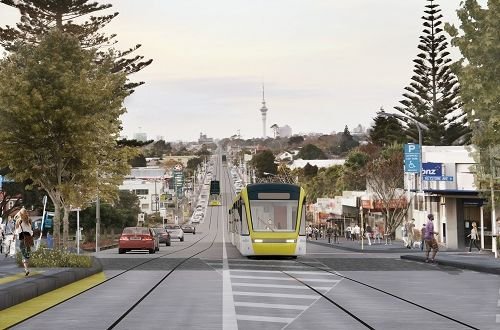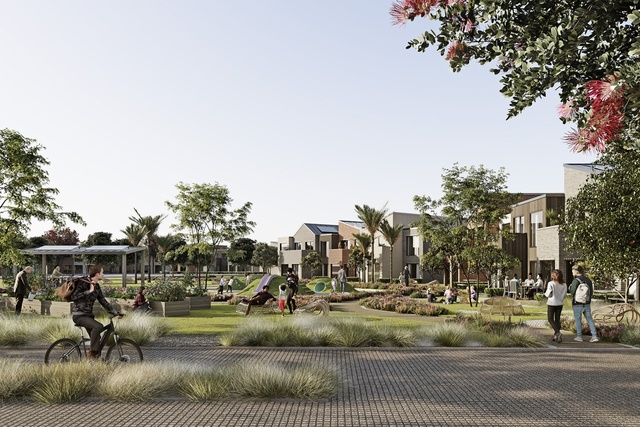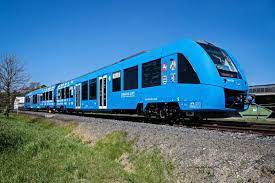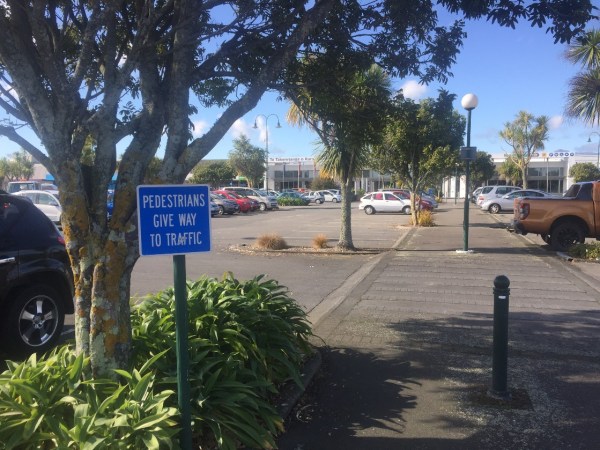The announcement of the Auckland Light Rail project to the airport was a big disappointment for all transport campaign groups. Greater Auckland support surface light rail all the way to the airport, while the Public Transport Users association (PTUA) and the Campaign for Better Transport (CBT), both supported light rail for the Auckland isthmus, but an extension of the Onehunga line to Wiri via the airport and the Mangere employment hub, and a connection to the proposed freight line from Avondale to Southdown.
Much of what was claimed as benefits in the government’s press release needs to be looked at more closely.
24km route with up to 18 stations or stops from the City Centre to Mangere and the airport, running every five minutes so people can turn up and go
Although this sounds impressive, as it will be underground, 18 stops will be a lot and will slow the (already) slow tram a lot more.
Capable of carrying up to 15,000 passengers per hour at peak, which is four times more passengers than a dedicated busway or trackless trams
This is half the capacity of rapid heavy rail, but is optimistic for light rail in this case which some observers fear might be, in fact, only about 5000 people per hour. Even at 15,000, it is unimpressive for the price tag.
Removal of up to 13 car lanes or taking 12,000* cars off the road, which is a great result for local streets, communities and carbon emissions (*average of 1.2 people per car)
This is a big claim, but would, if true, be only a fraction of the cars taken off roads around Auckland if Mangere was connected to South Auckland and West Auckland too, which a heavy rail option would offer.I would like to see the 13 lanes that they would actually close.
Integrates with current train and bus hubs and the City Rail Link stations and connections. Light rail can also be extended to the North Shore and North West without having to transfer from one line to the other
It will not link with South Auckland and will require commuters from the south to have to travel to Auckland to connect with western services (a service that exists now), but a new heavy rail link, soon to be built, would offer that connection more directly via Avondale.
Includes safe walking and cycling along the corridor and with connections to all stations
All new builds should be doing this.
Estimated to bring up to 66,000 new homes by 2051 and open up housing along the corridor in Mt Roskill, Onehunga and Māngere
Surface light rail could do this so much more efficiently. Also the tunnel trams may very likely be considered too slow in future and could be turned into an express ‘Metro Rail’ system, because of its tunnel and subsequently not serve a densified population well. Which begs the question, why does this weave all over Mangere and the CBD, yet travel in a straight line under the isthmus? Light rail on the surface is ideal for dense populations.
Selected light rail option will see transport available every five minutes from approx. 18 stops, cutting travel times from CBD to Airport in half for many
Again, this is a lofty claim. A car, taxi, taxi van or a bus (if there was one) could run non-stop from the CBD to the airport in a much quicker time (outside the peak), than the 18 stop tram could. It is also going to meander all through different parts of Mangere and CBD, slowing it further. An express heavy rail service using a third main with stops at Panmure, Otahuhu and Puhinui could complete the journey in a little over 30 minutes. The light rail option as it is designed now would potentially take not much less (or even over) twice that long.
Govt selects partially-tunnelled light rail from Auckland CBD–Airport, becoming the spine of Auckland’s future transport network
This is conveniently leaving out the fact that this meanders all over Mangere and the CBD, and that street capable trams are not designed for ‘rapid’ speeds. This would make the ‘spine’ a bit jelly-like.
Accelerating our economic recovery with the creation of up to 97,000 new jobs, and 66,000 homes by 2051
A speedy economic recovery that takes until 2051? I hope not! All this could have been achieved more easily with cheaper options, such as the heavy rail proposal and/or the surface light rail proposal on the Auckland isthmus. Heavy rail would likely create far more jobs, by efficiently linking up most of Auckland with the CBD, the Mangere employment hub, the airport and a variety of residential areas and work, education, health and entertainment destinations all over Auckland. We should be developing what we have got.
Business support package to be developed alongside affected businesses
This alludes to the politics of this project. The government avoided disruption along Dominion Road, but this could have been mitigated with a $20 million front loaded package to appease the Dominion Road businesses. This is a very small amount in the scheme of things, so why did the government shy away from Dominion Road? Could it be that this is the Minister of Transport’s electorate and he did not want to risk any sort of distress among his voters? Which begs the question, how much of this was to shore up the electorates of Mangere and Mt Roskill and to gain favour in the narrowly lost Auckland electorate? Is that a reason to select a particular route? I think not!
“We are not going to repeat the mistakes of ad hoc planning and a scramble to build infrastructure when it is too late – this rapid transit system is about making sure Auckland is able to flourish as it grows”.(Grant Robertson)
But we can’t get Te Huia into Britomart or to Newmarket, for want of a relatively cheap third main across the system. Heavy rail from Onehunga would link most of Auckland together, so why let an opportunity like this go wanting? Why not bring the Avondale to Southdown line forward to, at least get a connection from south to west via Westfield Junction? Again, develop what we have! …and the use of the term ‘rapid transit’ is misleading when applied to light rail. Light rail is a relatively slow tram.
“Our largest city needs a linked up rapid transit transport network that will serve Aucklanders into the future, making it faster to move through the city, connecting communities, providing greater access to businesses, all while reducing congestion,” (Michael Wood)
Wood is not describing the light rail scheme he just announced here. This is the heavy rail proposal. The light rail project is limited geographically, is not rapid and won’t make many journeys any faster. It will connect the communities between Mangere and the CBD only, ignoring West Auckland, South Auckland and East Auckland
The Government is taking the next step regarding Auckland light rail from the CBD to the Airport, and is proceeding with the option recommended by the Auckland Light Rail Establishment Unit, which will see Light Rail in a tunnel from Wynyard Quarter to Mt Roskill, which comes to the surface and runs alongside the SH20 motorway to the airport” (Michael Wood)
Two points from this statement. Firstly, the advisory Committee was given a very limited brief to advise about, limiting it to a limited route and length and type of transit, so other opportunities were not considered. Mentioning the running alongside SH20 starts alarm bells for me. There is a corridor there for a freight line for freight trains travelling from Whangarei/NorthPort to Southdown to avoid the congestion on the Newmarket route. Light rail is incompatible with heavy freight trains, so I am wondering where they are going to build their LR route. I sincerely hope that KiwiRail will protest loudly about that if they are wanting to use that land for LR!
Missed Opportunties
My understanding is that public transport has specific functions and benefits over other forms of transport, and they are;
- PT is the most efficient way to move large numbers of people across a city
- Rail PT uses much less land than the road system.
- PT reduces a lot of pollution from tyre dust and braking systems on road vehicles that pollute our waterways, and microplastics from tyres are the second biggest contributor to oceanic microplastics.
- PT offers greater equity in transport and enables better connectivity between communities suffering the tyranny of distance.
- In our current climate crisis, PT is the best way to reduce greenhouse gases.
So why did this project throw away opportunities to provide significant connectivity across the greater Auckland region by ignoring an existing plan of continuing to develop what we have and coming up with an extremely expensive, but very limited new plan. The original plan would serve the people of Mangere just as well but would serve far more people who are currently using and will continue to use their cars.
Expensive new equipment and facilities
- This new project will require a totally new type of rolling stock.
- It will require totally new facilities to store and maintain the rolling stock.
- It will be entirely incompatible with anything Auckland has currently in the way of rail transit.
- It will require new skills and the training of staff to work with this new system.
No one really talks about the next harbour crossing giving any clear indication of the need for it or the mode favoured.
This is a political hot potato, as there are many competing groups for the dollars required (much of it squandered on the LR tunnel to the airport). These groups are, PT commuters, motorists, the truck lobby, the bus lobby, the bike lobby and people who generally travel either way across the harbor to work, learn, for health appointments or play. This has brought about strong voices for greater use of the current bridge (add a cycle lane), and calls for a road tunnel. There is also a strong call for a rail tunnel, but some want light rail and others want heavy rail. Here are the solutions to that.
- Build a new bridge on the eastern side of the current bridge (sympathetic to the design of the original bridge). This bridge needs to be no more than three lanes wide and should be limited to buses, trucks and other heavy vehicles only. The trucks and others could be tolled. Two lanes southbound until midday then two northbound after that. This is a pragmatic solution as the road transport lobby is dissatisfied with the SH18/16/20 alternative route they will have to take soon as the current bridge was not designed for the heavy vehicles of today and is rapidly wearing out. It needs to be left to cars and other light vehicles only. The road transport lobby is currently lobbying for a tunnel for road vehicles for this reason. Give them the bridge.
- Do not under any circumstance build a road tunnel. It will be long and dangerous, and could potentially encourage thousands more cars into the CBD which would not cope.
- Build a rail tunnel. They are planning to extend the tram from the airport on this route, which is why initial mistakes can lead onto subsequent mistakes. A tram to the North Shore won’t cope by the 2040’s, but a heavy rail system could be effective for over 50 years due to its far greater capacity to transport so many more people than any other mode. A heavy rail system could also be extended well beyond city limits and provide services to outlying communities as well. In this case the line could connect with the North Auckland line at Kaukapakapa creating a circular route to West Auckland. It could also go directly up to Warkworth alongside the new motorway offering a similar service to the Sunshine Coast district in Queensland. For light rail, Albany is a long way.
The cost makes it unsafe
We have just been through a pandemic and increased our GDP debt ratio from a very healthy 9.2% to 15.2% (or debt level from $28 billion to $51.6 billion) and inflation from about, 1.62% in 2019 to 5.9% at year ending December 2020. Now the Minister says this is a good time to borrow. I’m not so sure. This is now a rapidly changing world, and a lot could come about which would change the idea of a big spend up on a somewhat controversial project like this. It is highly likely to be ditched if the current government loses the next election, and then we have to start all over again. It would have been so much easier to have developed the heavy rail system and followed the original plan that promoted that. We could almost be there by now, as this has been argued about since 2015!
Here is a quote from our PTUA Facebook page from one of our followers, which is a very relevant statement:
“Four transmission gullys! How can anyone in their right mind think this is acceptable? The same government has zero plans to improve or provide public transport throughout the rest of the country, they make massive spending available and blow it all on one project. Who would have thought a government could trump National's RON's for poor value for money, yet Labour have come up with a way”. (Geoff Blackmore)
An opinion by Niall Robertson, the Chair of the Public Transport Users Association (PTUA)



